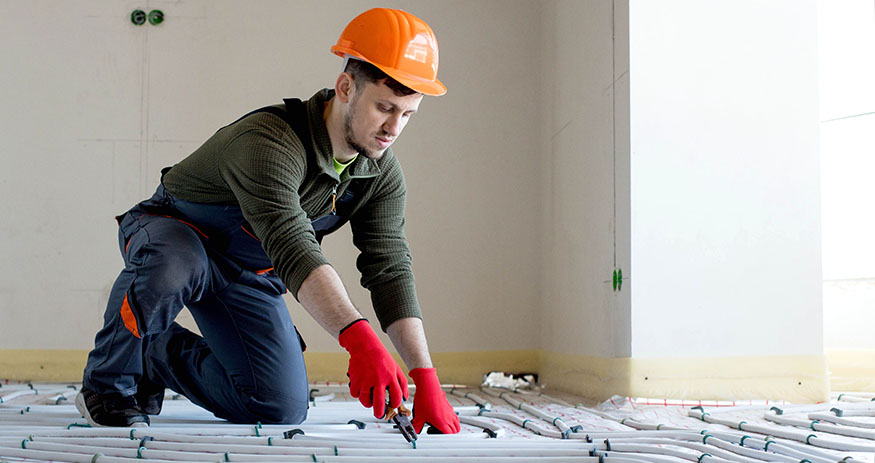
Gone are the days when we had to rely on traditional heating systems like furnaces and boilers to provide warmth to our homes during winter. Now, radiant in-floor heating basement systems are becoming everyone’s go-to heating solution. These not only keep your home warm but also offer a level of efficiency and comfort that is unmatched by traditional heating systems.
In this guide, we’ll help you understand the major benefits of installing a radiant heating system, particularly after the successful completion of basement underpinning. We’ll also take you through the basement radiation heating system and water radiant floor heating basement system that we at Rock Bottom Underpinning offer.
Basement radiant floor heating systems are those that contractors install underneath your flooring that will keep your home warm.
In-floor heating is aptly named for exactly how it’s installed and run. Rather than installing heating systems in your walls, a contractor will run the heat underneath your flooring to heat your home from the ground up. This is also why you’ll sometimes see In-Floor heat referred to as Underfloor.
Important Note: Before considering the installation of radiant floor heating, it is essential to ensure that any necessary structural work, such as underpinning, has been completed. Rock Bottom Underpinning specializes in this foundational work, setting the stage for a seamless radiant heating installation.
There are two main types of modern in-floor heating available today:
Electric In-Floor Heating: This system uses a network of electric heating cables or mats that are installed beneath the flooring. Once powered, these cables generate radiant heat, which directly warms the floor surface. Electric systems are often easier to install, making them ideal for smaller areas or retrofitting into existing homes. They are especially popular in bathrooms and kitchens, where homeowners seek extra warmth underfoot.
Hydronic In-Floor Heating: This system uses a network of pipes to circulate hot water under the floor. A boiler heats the water, which flows through the pipes, emitting radiant heat that gently warms the floor and rises throughout the room. Hydronic systems are generally more cost-effective for larger spaces or entire homes, as they are energy-efficient and can be powered by various heat sources, including gas, oil, or even solar energy.
How In-Floor Heating Works : Both types of in-floor radiant heating systems rely on radiant heat technology, which warms the floor evenly across the surface. As the floor heats up, it radiates warmth upward, effectively heating the room from the ground up. This method provides consistent, comfortable warmth without the need for forced-air systems that can create drafts, stir up dust, or cause noise.
Electric In-Floor Heating
Hydronic In-Floor Heating
So, Which One Should You Choose?
It depends on your situation:
Still unsure? A heating expert from Rock Bottom Underpinning can help you decide what’s best for your home, considering your specific needs and budget.
When it comes to enhancing the comfort and energy efficiency of your home, the in-floor radiant heating system is an excellent solution. And when it comes to installing this system, Rock Bottom Underpinning is the name you can trust. Here’s why:
Expertise and Experience:
Optimal Comfort and Energy Efficiency:
Professional Installation and Maintenance:
By choosing our underfloor heating company- Rock Bottom Underpinning, you’re investing in a system that will not only enhance your home’s comfort but also contribute to long-term savings.
The in-floor radiant heating system in Etobicoke offers numerous benefits, from energy efficiency to consistent comfort. While you may find radiant floor heating costs a bit higher, the long-term peaks make the heating system a worthwhile investment. Consider your home’s specific needs, insulation, and flooring material before deciding. Consult a reputed underfloor heating company like Rock Bottom Underpinning to determine if radiant floor heating Toronto service is right for your home, especially after the successful completion of any necessary underpinning work.